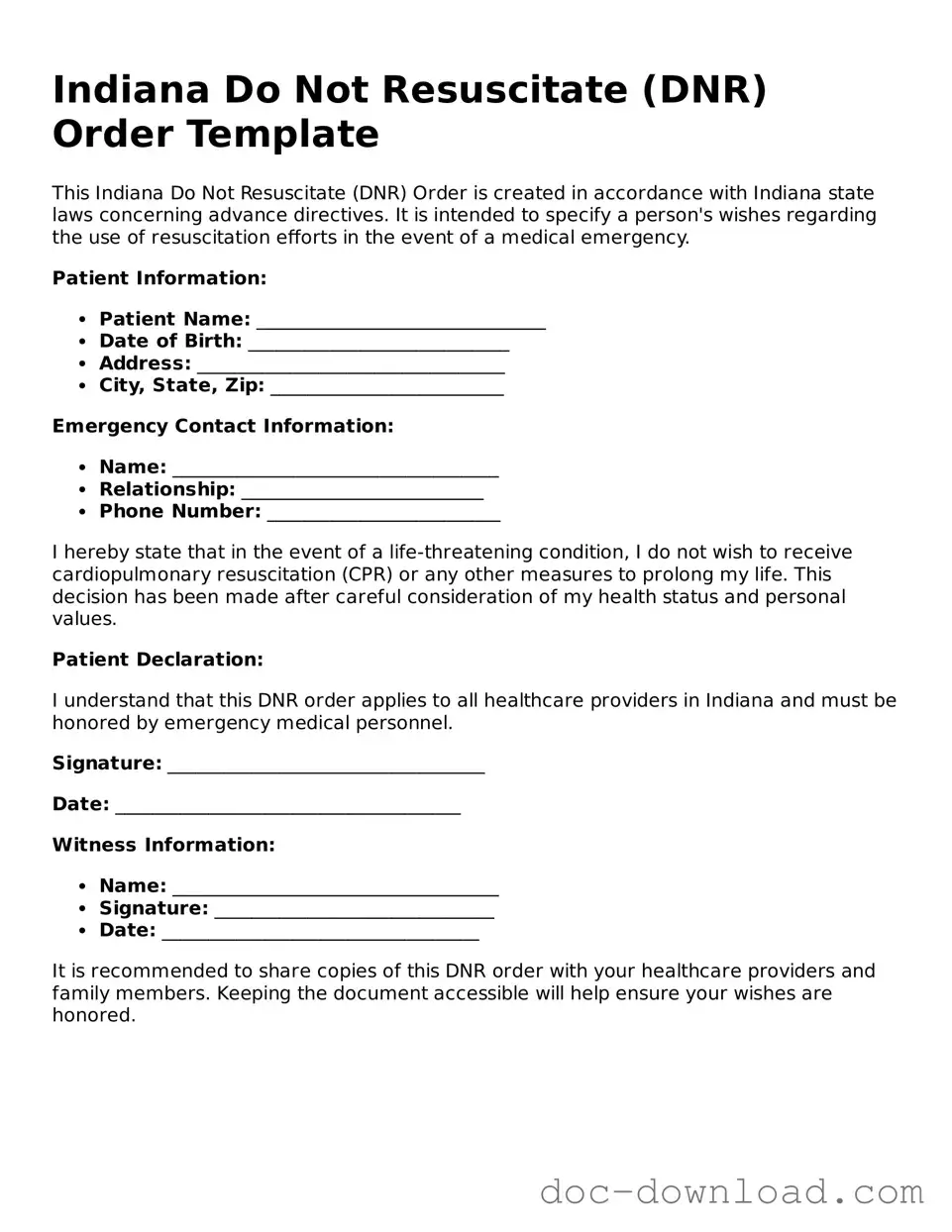The Indiana Do Not Resuscitate Order (DNR) form is similar to a Living Will, which outlines a person's preferences regarding medical treatment in the event they become unable to communicate. Both documents serve to express an individual's wishes about end-of-life care. A Living Will typically addresses broader medical decisions, while a DNR specifically focuses on the refusal of resuscitation efforts, making it a more targeted document for situations involving cardiac or respiratory arrest.
Another document akin to the DNR is the Medical Power of Attorney (MPOA). This legal instrument allows individuals to appoint someone to make healthcare decisions on their behalf if they become incapacitated. While the DNR provides specific instructions about resuscitation, the MPOA empowers an agent to make a range of medical decisions, which may include whether to initiate resuscitation based on the patient's overall condition and wishes.
The Physician Orders for Life-Sustaining Treatment (POLST) form shares similarities with the DNR by translating a patient’s preferences into actionable medical orders. Unlike a DNR, which is primarily focused on resuscitation, the POLST encompasses a wider array of treatment preferences, including the use of antibiotics, feeding tubes, and other life-sustaining measures. Both documents are designed to ensure that medical personnel honor a patient's wishes, but the POLST is more comprehensive in scope.
A similar document is the Advance Healthcare Directive, which combines elements of both a Living Will and a Medical Power of Attorney. It allows individuals to specify their healthcare preferences while also designating a trusted person to make decisions on their behalf. Like the DNR, the Advance Healthcare Directive aims to ensure that a patient's wishes are respected during critical medical situations, but it provides a broader framework for decision-making.
The Do Not Intubate (DNI) order is another document that is closely related to the DNR. A DNI specifically instructs medical personnel not to perform intubation in the event of respiratory failure, while a DNR focuses on not performing cardiopulmonary resuscitation (CPR). Both documents reflect a patient’s desire to avoid aggressive life-saving measures, but they target different interventions within the spectrum of emergency care.
The Comfort Care Order is also similar to the DNR in its intent to prioritize comfort over aggressive treatment. This order typically directs healthcare providers to focus on palliative care measures rather than life-sustaining interventions. While a DNR prohibits resuscitation, a Comfort Care Order emphasizes the importance of alleviating pain and ensuring quality of life during the dying process.
The Healthcare Proxy serves a role similar to that of a Medical Power of Attorney, allowing individuals to designate someone to make healthcare decisions for them. While it does not specifically address resuscitation, it can encompass decisions about DNR status based on the patient’s known wishes. This document ensures that someone trusted is available to advocate for the patient’s preferences in medical settings.
The Do Not Hospitalize (DNH) order is another document that aligns with the principles of the DNR. A DNH order indicates that a patient should not be transferred to a hospital for treatment, particularly in end-of-life situations. This reflects a preference for remaining in a familiar environment, which is often aligned with the goals of a DNR to avoid aggressive interventions that may not align with the patient’s wishes.
The Colorado Homeschool Letter of Intent form is essential for parents wishing to navigate the homeschooling process effectively. It is crucial for notifying the local education authorities of the parent's intention to homeschool, thereby ensuring compliance with Colorado's educational standards and regulations. For more detailed information, parents can visit Colorado PDF Forms, which provide valuable resources and templates to facilitate this important step.
Lastly, the End-of-Life Care Plan is similar to the DNR in that it encompasses a comprehensive approach to managing a patient's final days. This plan often includes preferences regarding resuscitation, pain management, and overall care goals. While the DNR focuses specifically on resuscitation, the End-of-Life Care Plan provides a broader context for ensuring that all aspects of a patient’s care align with their values and desires as they approach the end of life.
